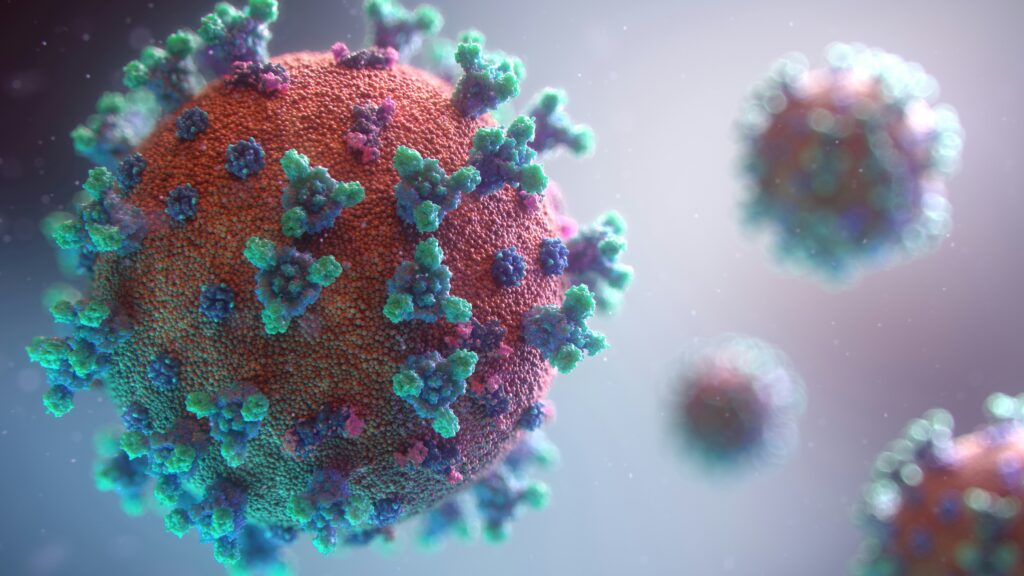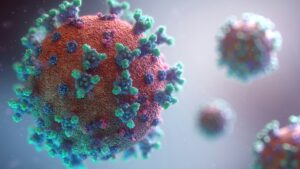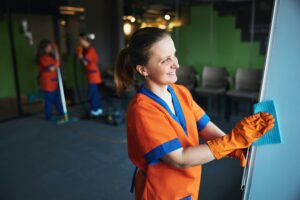When we think of germs and viruses, many people picture sneezes or coughs, but a significant amount of disease spread also occurs through contact with surfaces. In offices, furniture, desks, chairs, tables, and partitions can act as “fomites,” which are objects that carry infectious agents and contribute to the spread of germs.
At Bee Line, we know that clean office spaces aren’t just about appearance but also about your health, safety, and the productivity of your business. That’s why our cleaning teams use science-backed approaches to target germs and viruses where they live.
What Determines How Long a Virus or Germ Survives?
There’s no single answer — survival depends on many factors:
- Type of surface: Non-porous materials (plastic, metal, glass) allow germs to survive longer than porous fabrics.
- Temperature and humidity: Cooler, humid environments can help germs last longer; heat, dryness, or sunlight shorten survival.
- Amount of virus present: Larger contamination takes longer to degrade.
- Exposure to cleaning or disinfectants: Proper cleaning drastically shortens survival time.
- Type of germ or virus: Some are fragile and break down quickly, others are more resilient.
Because these factors vary, research usually gives ranges instead of exact times.
What Science Shows: Survival Times on Office‑Type Surfaces
Here’s what studies tell us:
| Material / Type | Approximate Survival Time* | Notes |
| Plastic, stainless steel (non‑porous) | Up to 2–3 days or more | Many viruses, including influenza and coronaviruses, can survive for days. |
| Glass / hard smooth surfaces | Several days possible | Smooth surfaces can allow droplets to linger for longer periods. |
| Fabric, upholstery, textiles | Hours to ~1 day | Viruses degrade more rapidly on porous materials; studies show a significant reduction within 12–24 hours. |
| Cardboard, paper | Up to ~1 day or less | Viruses generally survive for less time. |
| Copper surfaces | ~4 hours | Copper is naturally antimicrobial and shortens the survival of viruses. |
*Survival here means infectious virus — not just harmless fragments. Even if traces remain, infectivity usually drops sharply over time.
For example, research during the COVID-19 pandemic showed that virus particles could live anywhere from a couple of hours to a couple of days on surfaces, depending on the material and conditions. In real office environments, factors such as cleaning, airflow, and light exposure typically shorten that window.
Why This Matters for Offices
A desk’s hard surface or a metal table frame can host a detectable virus for days under ideal conditions. Fabric on chairs or partitions is less hospitable, usually losing viability within hours. High-touch surfaces, such as armrests, door handles, conference table edges, and light switches, are where germs are most likely to spread because they are frequently touched.
Bee Line’s cleaning teams focus on these high-touch zones as part of their daily and deep cleaning protocols. We ensure that surfaces that matter most are addressed first, using industry-leading techniques and EPA-registered disinfectants.
How Businesses Can Reduce the Risk
Here are practical steps to protect your office environment:
- Establish regular cleaning and disinfection
Daily cleaning should focus on high-touch surfaces, with periodic deep cleaning for furniture and other upholstered items. EPA‑registered disinfectants are essential. - Choose materials wisely
Select furniture with smooth, non‑porous finishes when possible. These are easier to clean and less likely to harbor germs in the long term. - Rotate and stagger shared spaces.
Reducing simultaneous use of conference rooms and shared equipment lowers surface exposure. - Improve ventilation
Fresh airflow and humidity control can reduce how long viruses survive indoors. - Act quickly after contamination
If someone is sick or surfaces are visibly soiled, clean immediately with proper disinfectants. - Train staff in hygiene and cleaning practices
Education about handwashing, surface hygiene, and proper cleaning protocols is key. - Use protective coverings
Removable, wipeable covers on high-touch surfaces help keep them sanitized.
Bee Line partners with businesses to establish cleaning schedules that combine daily maintenance with deep cleaning for furniture, partitions, and high-touch areas. This approach keeps workplaces healthier, safer, and more productive.
What It Doesn’t Mean
- Just because virus traces are detected doesn’t mean there is enough to cause infection.
- For many viruses, airborne or droplet transmission is more important than surface contact.
- Laboratory conditions often show longer survival times; however, in real life, factors such as cleaning, airflow, and sunlight tend to reduce survival times.
Key Takeaways
- Viruses can survive on office furniture for a few hours to multiple days, depending on the material and environmental conditions.
- Non-porous surfaces, such as plastic and metal, generally support prolonged survival compared to fabrics.
- Regular cleaning, wise furniture choices, proper ventilation, and professional cleaning services all reduce the risk.
- Working with a trusted partner like Bee Line ensures a cleaner, healthier workspace.
Bee Line brings expertise, the right equipment, and professional protocols to protect your business. We understand the science behind germs and viruses and design cleaning schedules that keep your office safe. Contact Bee Line to learn how we can keep your workspace fresh, clean, and healthy for your employees and clients.
About The Author
Julio Alvarez
author
Julio is a true veteran to the industry, rising through the ranks of the cleaning business and finding a home at Bee Line since 2007. When he’s not busy expertly leading his troops, you can find Julio playing soccer and spending time with his wife, 3 adorable boys, and a goldfish named Flipper! He has a soft spot in his heart for stuffed pizza with salad, and is a Cubs fan through and through. His favorite part of working at Bee Line is the strong teamwork.




